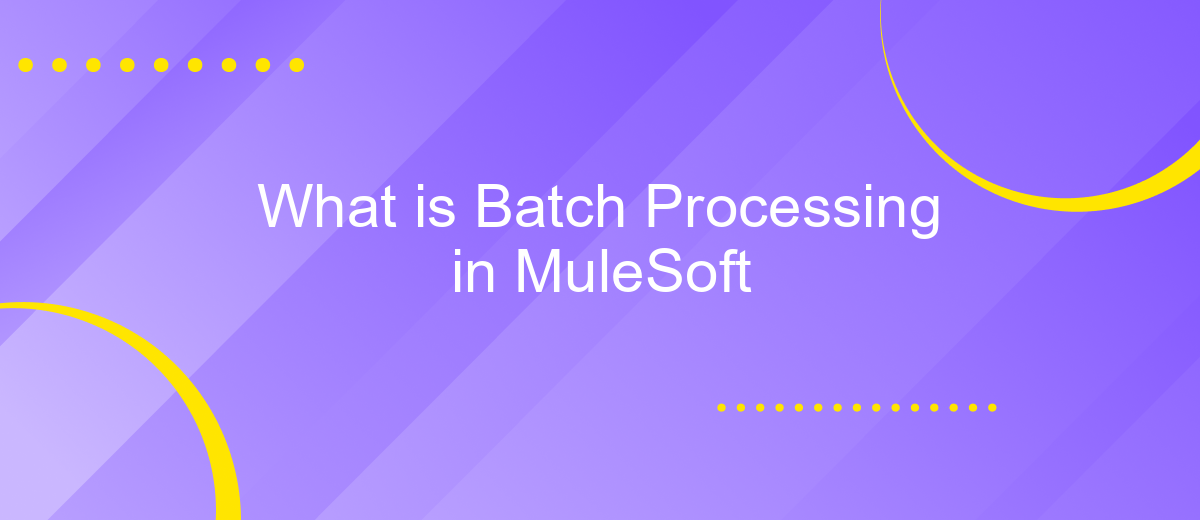What is Batch Processing in MuleSoft
Batch processing is a powerful feature in MuleSoft that enables the efficient handling of large volumes of data by processing it in chunks. This method is particularly useful for tasks such as data migration, integration, and synchronization. In this article, we will explore the fundamentals of batch processing in MuleSoft, its benefits, and how to implement it effectively in your integration projects.
Introduction to Batch Processing
Batch processing in MuleSoft is a powerful technique for handling large volumes of data efficiently. This method allows you to process data in chunks or batches, rather than handling it all at once, which can lead to improved performance and better resource management. By leveraging batch processing, organizations can streamline their data workflows and ensure smooth and reliable operations.
- Efficiently processes large datasets
- Improves resource management
- Streamlines data workflows
- Ensures smooth operations
One of the key benefits of batch processing in MuleSoft is its ability to integrate seamlessly with various services, such as ApiX-Drive. ApiX-Drive enables users to automate data transfers between different systems, ensuring that all necessary information is processed and synchronized accurately. This integration capability makes it easier for businesses to manage their data and maintain consistency across multiple platforms.
Advantages of Batch Processing

Batch processing in MuleSoft offers several advantages, making it an essential feature for handling large volumes of data efficiently. One of the primary benefits is the ability to process data in chunks, which optimizes resource utilization and reduces the load on the system. This ensures that even when dealing with massive datasets, the system remains responsive and performs well. Additionally, batch processing allows for better error handling and recovery, as it can isolate and manage errors within individual batches without affecting the entire process.
Another significant advantage is the seamless integration with services like ApiX-Drive, which facilitates the automation of data transfers between various applications. By leveraging batch processing, businesses can schedule and automate data synchronization tasks, ensuring that all systems are up-to-date without manual intervention. This not only saves time but also minimizes the risk of human error. Moreover, the ability to configure and customize batch jobs according to specific business requirements allows for greater flexibility and scalability, making it easier to adapt to changing needs and growing data volumes.
How Batch Processing Works

Batch processing in MuleSoft is a powerful feature that allows you to process large volumes of data efficiently by breaking it down into smaller chunks or batches. This method is particularly useful for handling data integration tasks that involve massive datasets, ensuring that system resources are optimally utilized and processing times are minimized.
- Data Collection: The process begins by collecting the data that needs to be processed. This data can come from various sources such as databases, APIs, or flat files.
- Batch Job Initialization: A batch job is initialized in MuleSoft, which defines the scope and parameters of the batch processing task.
- Data Splitting: The collected data is split into smaller, more manageable chunks or batches.
- Batch Execution: Each batch is processed sequentially or in parallel, depending on the configuration. During this step, data transformations, validations, and other processing tasks are performed.
- Completion and Aggregation: Once all batches are processed, the results are aggregated and any necessary post-processing tasks are executed.
Using tools like ApiX-Drive can further streamline the integration and automation of batch processing tasks in MuleSoft. ApiX-Drive offers seamless connectivity between various applications and services, making it easier to set up and manage data integrations without extensive coding.
MuleSoft's Batch Processing Module

MuleSoft's Batch Processing module is designed to handle large volumes of data efficiently by dividing them into manageable chunks, or batches. This module is particularly useful for processing extensive datasets that need to be integrated with various systems and applications.
One of the key features of MuleSoft's Batch Processing is its ability to ensure data consistency and reliability. It allows developers to configure and monitor the batch jobs, ensuring that each record is processed accurately and efficiently.
- Scalability: Handles large datasets by processing them in smaller, manageable batches.
- Reliability: Ensures data consistency and accuracy throughout the processing cycle.
- Flexibility: Easily integrates with various systems and applications through connectors.
- Monitoring: Provides tools to track and manage batch jobs effectively.
For those looking to streamline their integration processes, services like ApiX-Drive can be invaluable. ApiX-Drive offers a platform that simplifies the setup and management of integrations, making it easier to connect different systems without extensive coding. By combining MuleSoft's robust batch processing capabilities with ApiX-Drive's user-friendly interface, businesses can achieve seamless data integration and processing.
Applications of Batch Processing
Batch processing in MuleSoft finds extensive applications across various industries due to its efficiency in handling large volumes of data. In the financial sector, it is used for processing transactions, generating reports, and performing end-of-day calculations. Retail businesses leverage batch processing for inventory management, order processing, and customer data analysis. Healthcare organizations utilize it for patient data management, billing, and compliance reporting. By automating these repetitive tasks, businesses can save time and reduce errors, ensuring accurate and timely data processing.
In addition to these industry-specific applications, batch processing is crucial for integrating different systems and services. Tools like ApiX-Drive facilitate seamless data integration between various platforms, automating workflows and data transfers. This integration capability is essential for businesses that rely on multiple software solutions, as it ensures data consistency and streamlines operations. By leveraging MuleSoft's batch processing and integration tools like ApiX-Drive, companies can enhance their operational efficiency and maintain a competitive edge in their respective markets.


FAQ
What is Batch Processing in MuleSoft?
How does Batch Processing work in MuleSoft?
What are the main components of a Batch Job in MuleSoft?
Can Batch Processing handle failures or errors in MuleSoft?
What are some best practices for implementing Batch Processing in MuleSoft?
Routine tasks take a lot of time from employees? Do they burn out, do not have enough working day for the main duties and important things? Do you understand that the only way out of this situation in modern realities is automation? Try Apix-Drive for free and make sure that the online connector in 5 minutes of setting up integration will remove a significant part of the routine from your life and free up time for you and your employees.

